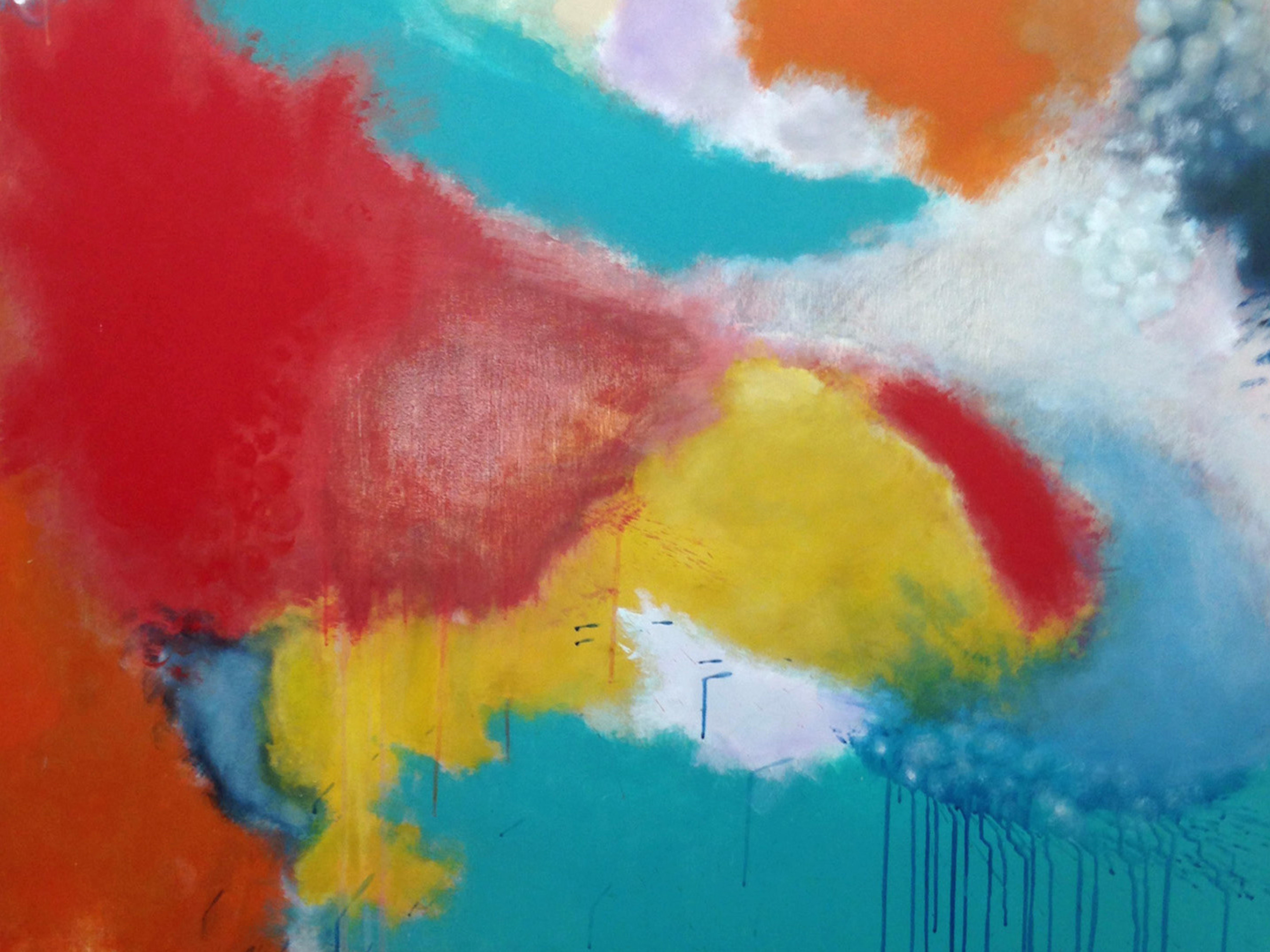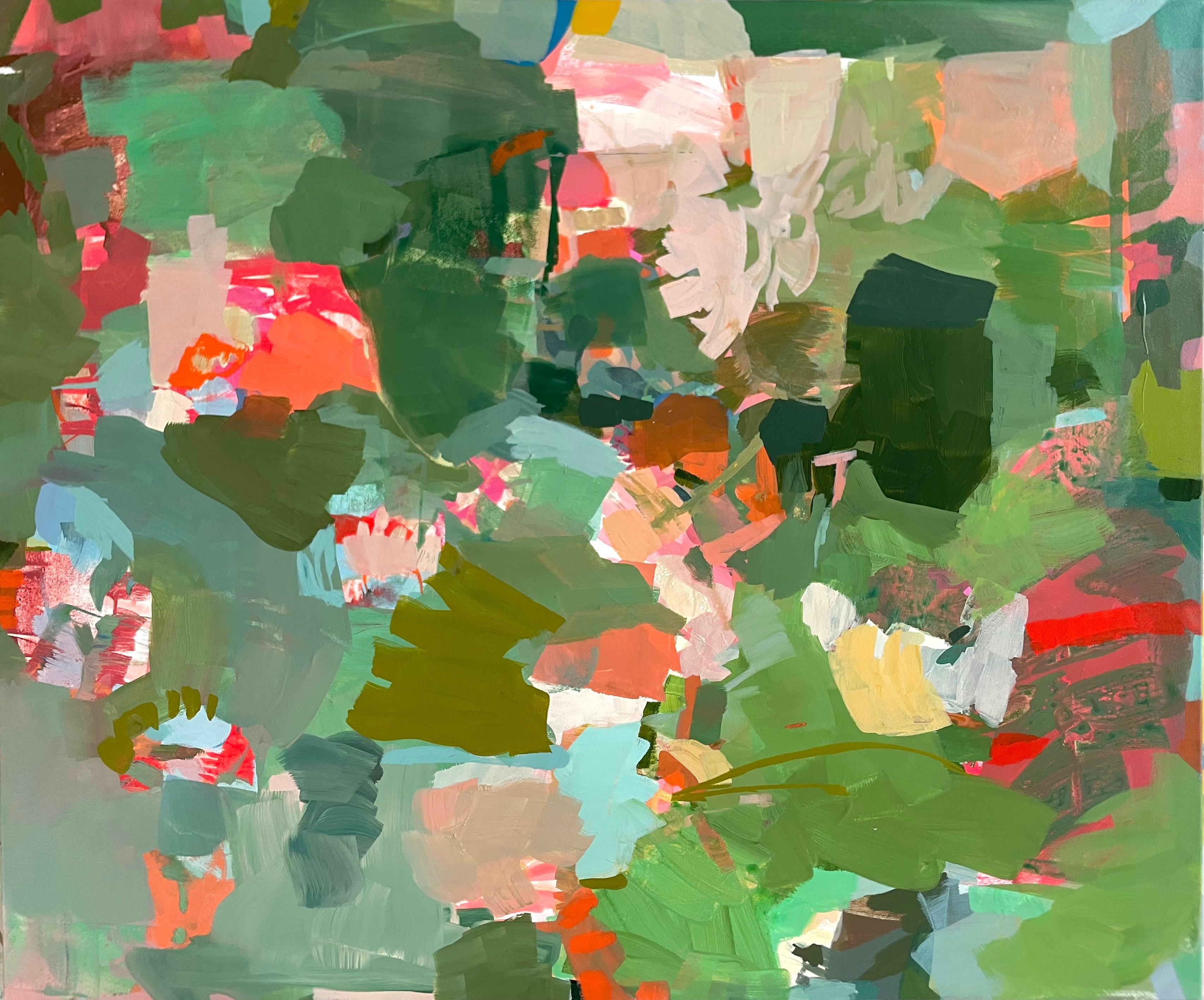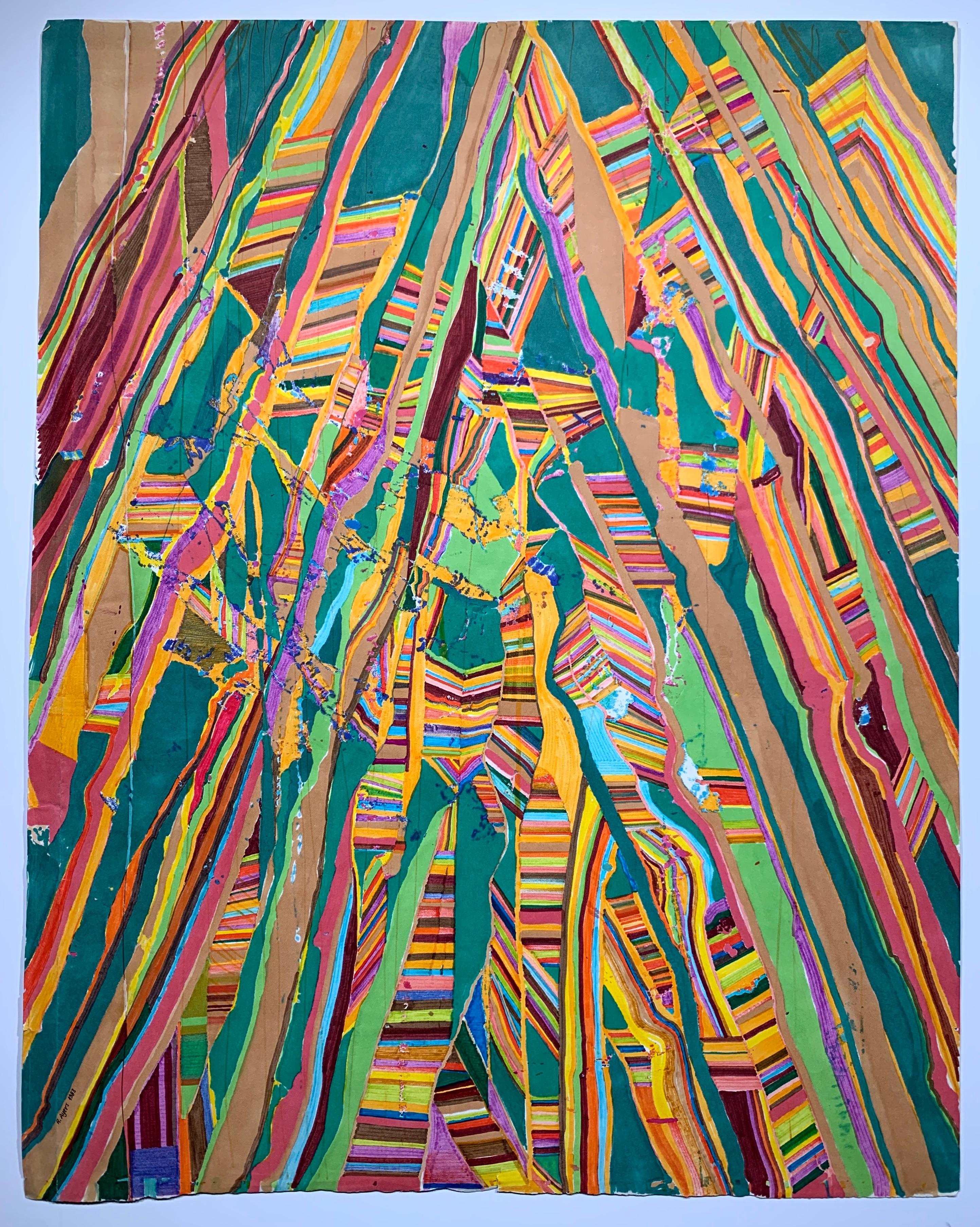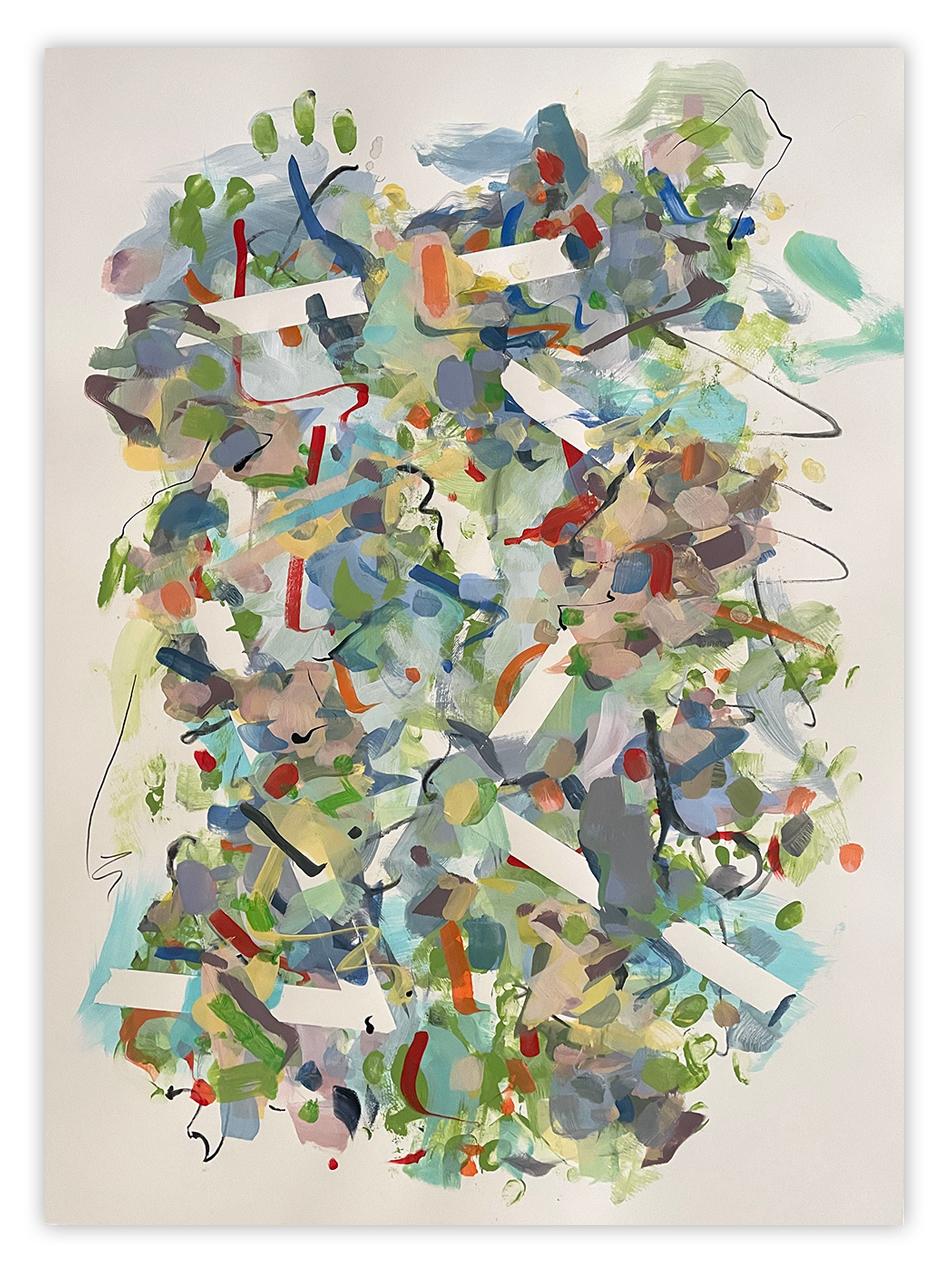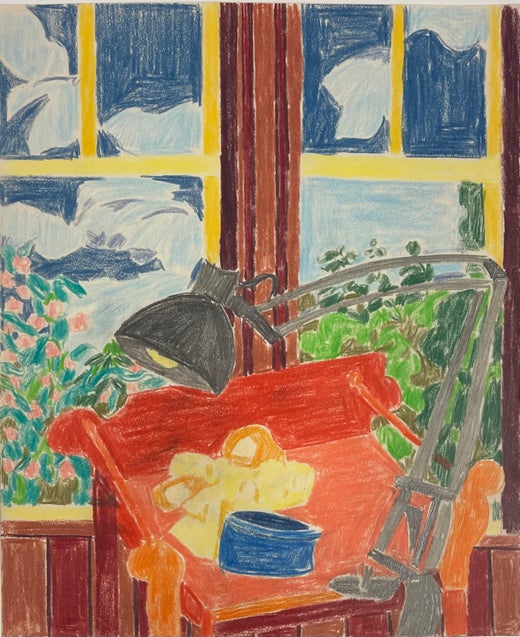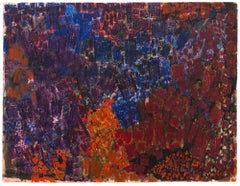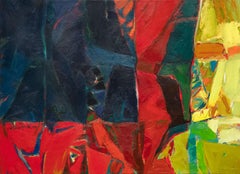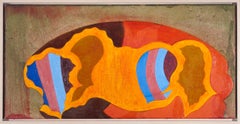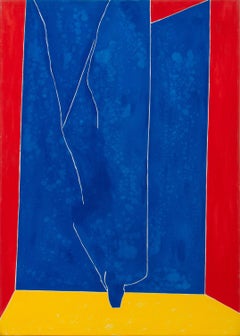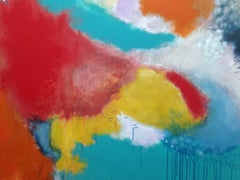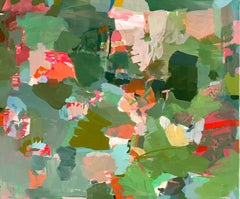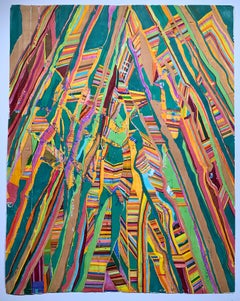Video Loading
Want more images or videos?
Request additional images or videos from the seller
1 of 15
Lynne DrexlerSporadic Spring1963
1963
$325,000
£246,433.45
€282,742.98
CA$462,435.21
A$501,637.73
CHF 263,789.14
MX$6,103,917.12
NOK 3,297,789.18
SEK 3,110,220.18
DKK 2,111,038.41
About the Item
Lynne Mapp Drexler's "Sporadic Spring" (1963) exemplifies her dynamic approach to color and gesture during her revered 1960s period, a formative decade that has recently been celebrated in the major exhibition "Lynne Drexler: Color Notes" at the Farnsworth Art Museum. The canvas is entirely covered in dense layers of short, repetitive brushstrokes rendered in vivid greens, reds, and oranges. These strokes coalesce into an array of circles, rhombuses, and rectangles, forming a "sporadic" yet remarkably harmonious mosaic that activates the entire surface of the painting. In this work, color takes precedence over form, with Drexler using chromatic intensity to create rhythm and structure. Her technique resonates with Hans Hofmann's influential "push-pull" theory, in which color relationships generate spatial depth and tension without relying on traditional perspective. At the same time, the gestural vigor and improvisational quality of the brushwork reflect the influence of her teacher Robert Motherwell, who encouraged expressive freedom and emotional immediacy. "Sporadic Spring" captures Drexler's synthesis of discipline and spontaneity, revealing how she forged a distinct voice within the New York School while anticipating the lyrical abstraction that would define her mature style.
Signed, titled and dated on verso, "Sporadic Spring 1963 Lynne Drexler”
Provenance:
Lupine Gallery, Monhegan, Maine
Private Collection, acquired from the above
Phillips New York, Wednesday, November 15, 2023, Lot 106
Private Collection, acquired from the above
- Creator:Lynne Drexler (1928-1999, American)
- Creation Year:1963
- Dimensions:Height: 40 in (101.6 cm)Width: 29.5 in (74.93 cm)
- Medium:
- Movement & Style:
- Period:
- Condition:
- Gallery Location:Palm Desert, CA
- Reference Number:Seller: 475651stDibs: LU9317001772
Lynne Drexler
Southern-born Lynne Mapp Drexler found her artistic voice during one of the most exciting and significant art movements of the 20th century. Born in Newport News, Virginia, in 1928, Drexler began her study of art as a child. After attending the College of William and Mary, Drexler became interested in contemporary art. She was encouraged to explore this venue by her uncle, who had ties to the Hudson River School of painting. After moving to New York in 1956, Drexler immersed herself in the world of Abstract Expressionism studying with Hans Hofmann in both his Provincetown and New York schools. She eventually went on to study with Robert Motherwell, at Hunter College. His views on Abstract Expressionism guided Drexler's own process. Her academic training from Motherwell would set the foundation for the style of painting for which she is known. Drexler's swatch-like patterns and painterly blossoms of color are quite unique when compared to her contemporaries of the Abstract Expressionist genre. By 1961, Drexler would have her first solo show at the Tanager Gallery. In 1961, Drexler married painter John Hultberg, whom she met at the Artists Club. The couple was already integrated into the bohemian lifestyle of the New York art scene. To occasionally escape the pressures of New York, Hultberg's art dealer, Martha Jackson, bought him a house on Monhegan Island, Maine, which had a small summer art colony. These musically influenced sketches would also become incorporated into an entire Unlike her male counterparts, Drexler found it difficult finding gallery representation in the gender-biased atmosphere of the New York gallery world. Hultberg, on the other hand, was quite successful and was considered a talented up-and-comer as an abstract artist. The relationship between Drexler and Hultberg was often tumultuous and the couple would routinely separate throughout their lives. As the mid 1960s approached, the movement of Abstract Expressionism was coming to a closet. She would also lament that "[New York] was no longer a place of stimulation for me. I had no respect for most of the artists working there. They were out to make it. They had no commitment to art." Drexler was already making her own natural transition. to abstract landscape painting. Many of her paintings created just after 1962 are clearly inspired by the landscape with the concepts of musical elements helping to guide the pictorial arrangements. Unhappy with the male-dominated art system and art politics of New York, Drexler finally moved permanently to Monhegan Island in 1983. The remoteness and solitude of the island would impact her work. Her paintings often reflect the everyday routines of life such as views from her windows, interior views of her house and even chores such as hanging laundry. When Drexler was diagnosed with cancer her biggest fear was that she would have to die on shore. Her closest friends became her hospice care group. Drexler passed away in 1999 on Monhegan Island.
About the Seller
4.8
Recognized Seller
These prestigious sellers are industry leaders and represent the highest echelon for item quality and design.
Established in 1996
1stDibs seller since 2011
113 sales on 1stDibs
Typical response time: 8 hours
- ShippingRetrieving quote...Shipping from: Palm Desert, CA
- Return Policy
Authenticity Guarantee
In the unlikely event there’s an issue with an item’s authenticity, contact us within 1 year for a full refund. DetailsMoney-Back Guarantee
If your item is not as described, is damaged in transit, or does not arrive, contact us within 7 days for a full refund. Details24-Hour Cancellation
You have a 24-hour grace period in which to reconsider your purchase, with no questions asked.Vetted Professional Sellers
Our world-class sellers must adhere to strict standards for service and quality, maintaining the integrity of our listings.Price-Match Guarantee
If you find that a seller listed the same item for a lower price elsewhere, we’ll match it.Trusted Global Delivery
Our best-in-class carrier network provides specialized shipping options worldwide, including custom delivery.More From This Seller
View AllUntitled (Dark)
By Lynne Drexler
Located in Palm Desert, CA
Lynne Mapp Drexler's "Untitled (Dark)" (1962) reflects the artist's revered 1960s period, a formative decade recently honored in the exhibition "Lynne Drexler: Color Notes" at the Fa...
Category
1960s Abstract Abstract Paintings
Materials
Paper, Oil Crayon
Untitled
Located in Palm Desert, CA
A painting by Jae Kon Park. ""Untitled"" is an abstract painting, oil on canvas in reds, yellows, and blues by Korean, Post-War artist Jae Kon Park. The artwork is signed in the lower right, ""Jaw Kon Park, 92"". Born in South Korea, Park Jae Kon...
Category
Late 20th Century Post-War Abstract Paintings
Materials
Oil
$35,000
Untitled
By Thomas Nozkowski
Located in Palm Desert, CA
An abstract, oil on linen on panel painting executed in bright oranges, blues and dark tans and browns by Post War artist Thomas Nozkowski. Signed verso, "Thomas Nozkowski."
Nozk...
Category
1990s Post-War Abstract Paintings
Materials
Linen, Oil, Panel
$44,000 Sale Price
48% Off
New Synthesis #15
By Jack Roth
Located in Palm Desert, CA
An abstract acrylic on canvas executed in bright, primary red, blue and yellow by Post War artist Jack Roth. Signed, dated and titled verso, "ROTH81 "NEW SYNTHESIS - 15".
Category
1980s Post-War Abstract Paintings
Materials
Acrylic, Canvas
$62,400 Sale Price
26% Off
#2
By Jack Roth
Located in Palm Desert, CA
An abstract acrylic on canvas painting executed in deep black, orange and yellow ochre on a white background by Post War artist Jack Roth. Signed verso, "JR-33-76."
Jack Roth (192...
Category
1970s Post-War Abstract Paintings
Materials
Canvas, Acrylic
$44,000 Sale Price
20% Off
Apollo XL
Located in Palm Desert, CA
A painting by Robert Natkin. "Apollo XL" is an abstract expressionist painting, acrylic on canvas in a colorful palette by Post-War American artist Robert Natkin. The artwork is signed in the lower right, "Natkin". Robert Natkin (1930-2010) was born in Chicago and graduated from the Art Institute of Chicago in 1952. Natkin’s art blends Abstract Expressionism with Post-Impressionist colors. His work often runs in series he created using columns...
Category
Mid-20th Century Post-War Abstract Paintings
Materials
Acrylic
You May Also Like
Spring Fever
By Toma Yovanovich
Located in Buffalo, NY
An original mid century modern abstract expressionist painting by American artist Toma Yovanovich.
Toma Yovanovich (1931-2016) was a painter/printmaker whose work is in collect...
Category
1960s Abstract Abstract Paintings
Materials
Acrylic, Canvas
Savin Spring
By Don Wunderlee
Located in Boston, MA
Artist Commentary:
An artist friend offered me her outdoor studio a half mile from the beach on Savin Ave. which was surrounded by rose bushes and visiting hummingbirds. It proved t...
Category
21st Century and Contemporary Abstract Abstract Paintings
Materials
Acrylic, Wood
Fields of Study
Located in Dallas, TX
acrylic on canvas
Category
2010s Abstract Abstract Paintings
Materials
Canvas, Acrylic
Untitled
By Roland Ayers
Located in Wilton Manors, FL
Roland Ayers (1932-2017). Untitled, 1983. Ink on paper, measures 17 x 23 inches. Unframed and unmounted. Signed and dated lower left. Ayers holds the distinction of having participated in the first important survey of African-Americans, Contemporary Black Artists in America, a 1971 show at The Whitney.
Biography:
Artist and art educator, Roland Ayers was born on July 2, 1932, the only child of Alice and Lorenzo Ayers, and grew up in the Germantown district of Philadelphia. Ayers served in the US Army (stationed in Germany) before studying at the Philadelphia College of Art (currently University of the Arts). He graduated with a BFA in Art Education, 1954. He traveled Europe 1966-67, spending time in Amsterdam and Greece in particular. During this period, he drifted away from painting to focus on linear figurative drawings of a surreal nature. His return home inaugurated the artist’s most prolific and inspired period (1968-1975). Shorty before his second major trip abroad in 1971-72 to West Africa, Ayers began to focus on African themes, and African American figures populated his work almost exclusively.
In spite of Ayers’ travel and exploration of the world, he gravitated back to his beloved Germantown, a place he endowed with mythological qualities in his work and literature. His auto-biographical writing focuses on the importance of place during his childhood. Ayers’ journals meticulously document the ethnic and cultural make-up of Germantown, and tell a compelling story of class marginalization that brought together poor families despite racial differences. The distinctive look and design of Germantown inform Ayers’ visual vocabulary. It is a setting with distinctive Gothic Revival architecture and haunting natural beauty. These characteristics are translated and recur in the artist’s imagery.
During his childhood, one of the only books in the Ayers household was an illustrated Bible. The images within had a profound effect on the themes and subjects that would appear in his adult work. Figures in an Ayers’ drawing often seem trapped in a narrative of loss and redemption. Powerful women loom large in the drawings: they suggest the female role models his journals record in early life. The drawings can sometimes convey a strong sense of conflict, and at other times, harmony. Nature and architecture seem to have an antagonistic relationship that is, ironically, symbiotic.
A critical turning point in the artist’s career came in 1971 when he was included in the extremely controversial Whitney Museum show, Contemporary Black Artists in America. The exhibition gave Ayers an international audience and served as a calling card for introductions he would soon make in Europe.
Ayers is a particularly compelling figure in a period when black artists struggled with the idea of authenticity. A questioned often asked was “Is your work too black, or not black enough?” Abstractionists were considered by some peers to be sell-outs, frauds or worse. Figurative* work was accused of being either sentimental or politically radical depending on the critical source. Ayers made the choice early on to be a figurative artist, but considered his work devoid of political content.
Organizations such as Chicago’ s Afri-Cobra in the late 1960‘s asserted that the only true black art of any relevance must depict the black man and woman...
Category
1980s Abstract Abstract Paintings
Materials
Paper, Ink
$960 Sale Price
20% Off
Spring Song #2
By Danny Morgan
Located in New York, NY
Abstract work of art. Acrylic on canvas.
Category
2010s Abstract Abstract Paintings
Materials
Canvas, Acrylic
Early Spring (Abstract painting)
By Gina Werfel
Located in London, GB
Early Spring (Abstract painting)
Acrylic and mixed media on paper - unframed
Werfel employs expressive, lyrical gestures that create bursts of movement and energy. Her color choice...
Category
2010s Abstract Abstract Paintings
Materials
Paper, Mixed Media, Acrylic
Read More
Penelope Gottlieb’s Comic-Style Painting Is a Requiem for a Vanished Flower
This piece may look like Pop art fun, but embedded within is a message of a planet on the brink.
10 Reasons Art Collectors Are Obsessed with Andy Warhol
More than three decades after his death, the prolific Pop artist and cultural icon's body of work continues to captivate. Here's a primer of some of his most notable motifs and mediums.
